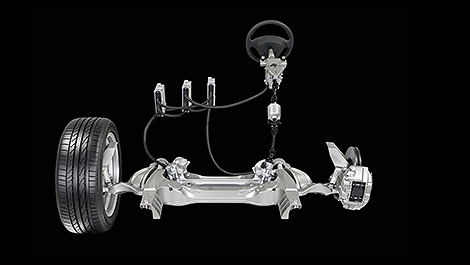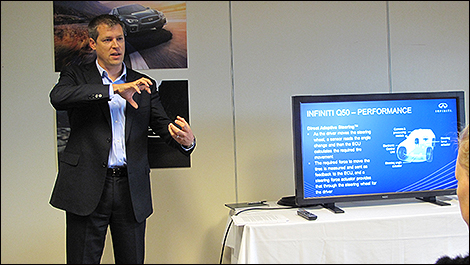Oct
7th
Stay connected Subscribe to our RSS feed
Even though Infiniti doesn't use the term, the Q50's Direct Adaptive Steering is “drive by wire” and represents the first time this technology has ever been offered on a production vehicle.
The steering wheel controls the front wheels without any direct mechanical link to those wheels.
“So many of the new technologies today are about safety and infotainment, this one is great because it directly enhances the driving experience,” says Tim Franklin, Senior Manager for Product Planning at Nissan Canada.
The Pieces
While the system is groundbreaking, the components that make it happen are all stuff we've seen before: sensors, ECUs, electric motors, etc.
As the driver moves the steering wheel, a sensor reads the angle change and then the ECU calculates the required tire movement.
Two electric motors mounted on the steering rack (one for each front wheel) power the tire movement.
The required force to move the tires is measured and sent as feedback to the ECU. The ECU then sends a simulated feedback to the steering wheel by the steering-force actuator. In this way the steering wheel always reflects the actual traction condition, and how easy or hard it is for the front wheels to turn in various road situations (high-speed turn, low speeds, wet pavement, gravel, snow, etc.).
This continuous feedback loop keeps the driver feeling connected to the road.
Franklin notes that most consumers might assume drive-by-wire steering is “video-game like.” It's not, says Franklin, because the Direct Adaptive System is a closed loop, with continuous feedback.
The Benifits
One of the main advantages of the system is eliminating “dirty noise” vibrations being transmitted back up the steering wheel. Obviously some road feel is good, but you always get some bad with the good. You don't get any bad vibrations with this system.
Another advantage is steering precision. In traditional systems, the steering rack is soft-mounted to the frame, via bushings. With the drive-by-wire, the rack is hard mounted, which increases steering control and precision.
Another advantage is faster steering response; there is virtually no lag between components.
The final advantage is that other features can be developed and added to the vehicle by leveraging the components and abilities of Direct Adaptive Steering.
One such feature is the ability to select several steering effort and response settings: Sport, Standard or Touring. There is even a Custom setting, where you can opt for a different steering effort (Heavy, Middle, Light) if you prefer a different one than the pre-sets.
Active Lane Control is another feature enabled by Direct Adaptive Steering, and Infiniti claims it's the world's first such technology. When engaged, as part of a suite of driver aids, a forward-facing camera mounted top centre in the windshield looks for lane markings and sends data to the ECUs, which automatically makes steering adjustments to keep you in the centre of the lane.
Franklin says the feature virtually eliminates the constant fine-tuning a driver subconsciously makes during long highway runs, and keeps the driver more relaxed.
While Direct Adaptive Steering debuted on the Q50 luxury sports sedan, Franklin says there is no reason the technology could not be utilized on a broad range of future vehicles.
In the unlikely event of a power supply disruption, an electric clutch defaults to engage the steering shaft, providing back-up conventional mechanical steering.
The steering wheel controls the front wheels without any direct mechanical link to those wheels.
“So many of the new technologies today are about safety and infotainment, this one is great because it directly enhances the driving experience,” says Tim Franklin, Senior Manager for Product Planning at Nissan Canada.
The Pieces
While the system is groundbreaking, the components that make it happen are all stuff we've seen before: sensors, ECUs, electric motors, etc.
As the driver moves the steering wheel, a sensor reads the angle change and then the ECU calculates the required tire movement.
Two electric motors mounted on the steering rack (one for each front wheel) power the tire movement.
The required force to move the tires is measured and sent as feedback to the ECU. The ECU then sends a simulated feedback to the steering wheel by the steering-force actuator. In this way the steering wheel always reflects the actual traction condition, and how easy or hard it is for the front wheels to turn in various road situations (high-speed turn, low speeds, wet pavement, gravel, snow, etc.).
This continuous feedback loop keeps the driver feeling connected to the road.
Franklin notes that most consumers might assume drive-by-wire steering is “video-game like.” It's not, says Franklin, because the Direct Adaptive System is a closed loop, with continuous feedback.
 |
| Photo: Infiniti |
The Benifits
One of the main advantages of the system is eliminating “dirty noise” vibrations being transmitted back up the steering wheel. Obviously some road feel is good, but you always get some bad with the good. You don't get any bad vibrations with this system.
Another advantage is steering precision. In traditional systems, the steering rack is soft-mounted to the frame, via bushings. With the drive-by-wire, the rack is hard mounted, which increases steering control and precision.
Another advantage is faster steering response; there is virtually no lag between components.
The final advantage is that other features can be developed and added to the vehicle by leveraging the components and abilities of Direct Adaptive Steering.
One such feature is the ability to select several steering effort and response settings: Sport, Standard or Touring. There is even a Custom setting, where you can opt for a different steering effort (Heavy, Middle, Light) if you prefer a different one than the pre-sets.
Active Lane Control is another feature enabled by Direct Adaptive Steering, and Infiniti claims it's the world's first such technology. When engaged, as part of a suite of driver aids, a forward-facing camera mounted top centre in the windshield looks for lane markings and sends data to the ECUs, which automatically makes steering adjustments to keep you in the centre of the lane.
Franklin says the feature virtually eliminates the constant fine-tuning a driver subconsciously makes during long highway runs, and keeps the driver more relaxed.
While Direct Adaptive Steering debuted on the Q50 luxury sports sedan, Franklin says there is no reason the technology could not be utilized on a broad range of future vehicles.
In the unlikely event of a power supply disruption, an electric clutch defaults to engage the steering shaft, providing back-up conventional mechanical steering.
 |
| Tim Franklin, Senior Manager, Product Planning, Nissan Canada, is amped up about Direct Adaptive Steering, a technology he feels directly enhances the driving experience. |
 The latest auto news, reviews, prices, product and vehicle releases.
The latest auto news, reviews, prices, product and vehicle releases.